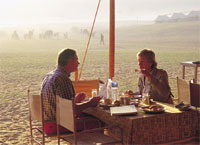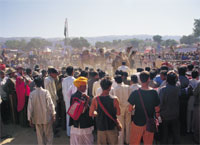



|
The Pushkar Cattle Fair
FARZANA CONTRACTOR rides rough to experience the annual Pushkar Mela in Rajasthan, not to buy a camel, but to soak in the local culture and learn more about its people and their animals. |
|
But camels apart, it�s also the handsome Marwari horses which catch your attention. They are grand looking, and if I have got my facts right come from western Rajasthan and are known as Malani horses. These are good for general riding, also for polo. Last year an exceptionally good horse sold for Rs. 5,50,000. There are horse breeder associations formed to standardise the breed, train them, ready them for international endurance tests, to enter them in the Middle East arena. Obviously they are more expensive than the camels which are used primarily for tilling the soil, transportation, etc. But camel breeding happens predominantly in Rajasthan. Needless to add this is the biggest camel fair in the country. The biggest horse market though is in Kathiawar, Gujarat.
The security all around the town is immense, as it would be when any such large gathering takes place. Police presence is most conspicuous and a very strict rule of NO VEHICLES in the walking zone is established. So don�t even think of messing with the authorities or try getting special permission from the Police Commissioner, it doesn�t work, even if you have papers in hand permitting you to drive through the main street. Besides, it�s not worth it either, because in order to enjoy that atmosphere, walk you must, blazing sun notwithstanding. The whole town becomes one colourful place. Crowded and noisy, glass bangles being sold, women squatting by the roadside
having henna applied on their palms, enjoying hot street food, ferris wheels full of children, turning round and round, music blaring.
When you are done with all the physical activity and want to sit down and sigh, you should head towards the Pushkar Palace. Find yourself a �mooda�, the cane chair reminiscent of the British Raj, in the Garden Lounge, order yourself a fresh lime soda, sweet, and watch across the waters of the lake where you will find the process of the holy dipping still going on, amidst tiny, earthen, lit diyas floating by the banks of the waters. Makes you realise how wonderful India is and how seeped in culture and tradition we are.
Later when I drove around, I stumbled upon another good location, the Jagat Palace, nestling in the Snake Mountain with the Thar sand dunes on the other. It is adorned with hand paintings, frescoes, gold leaf inlay work, period furniture and fixtures. This hotel has a rather enterprising list of sights to see. They organise a visit to the Durga Sharif, take you to the Nasiyan Temple in the heart of the old Ajmer city, which has the Savran Nagari hall vividly decorated with coloured glass mosaics and large gilded wooden figures, recreating scenes of Jain mythology. They also arrange a visit to the Rajputana Museum in the old city located in Emperor Akbar�s fort and palace which houses impressive sculptures dating from the 4th to the 12th century.
Indeed there is much to do in and around Pushkar and even en route from or to Delhi or Jaipur. If you have the time and no schedule in hand, drive around leisurely. Stop where your fancy catches you, there are innumerable places to spend a night at and enjoy the lure of the magical, medieval Rajasthan.
The Pushkar Mela this year
will take place between November
10 and 17.
For reservations at the Royal Camp,
|

Home Page
About the mag
Subscribe
Advertise
Contact Us
 I spent the entire day at the cattle grounds, driving around in a camel cart, the �Rajasthani car�. It�s rough but so much fun. A mini adventure of sorts. Very easily I became a part of it all. That must be because the entire atmosphere is so real, the people so unaffected, so welcoming. Funny in spite of belonging to a high level social circuit of Bombay for 20 long years, I have never felt the ease at a cocktail party as I did at this, another kind of cocktail mix, a cattle party shall say? I found myself in a happy whirl, stopping for a chat with a group sitting in the shade, meaning under their cart, enquiring how it goes, or watching carefully the behaviour of camels, even trying to get a closer look at their teeth! I knew I would not be creating room for another opportunity of such a kind and I sure did want to make the most of this visit. But there was a dilemma: do I record it all in my mind�s eye or through my lens eye! I found a balance and did both, but let me add the camel cart didn�t help in my balancing act. I was thrown around quite a bit, try standing in a moving camel cart doing pictures and you will know what I mean.
I spent the entire day at the cattle grounds, driving around in a camel cart, the �Rajasthani car�. It�s rough but so much fun. A mini adventure of sorts. Very easily I became a part of it all. That must be because the entire atmosphere is so real, the people so unaffected, so welcoming. Funny in spite of belonging to a high level social circuit of Bombay for 20 long years, I have never felt the ease at a cocktail party as I did at this, another kind of cocktail mix, a cattle party shall say? I found myself in a happy whirl, stopping for a chat with a group sitting in the shade, meaning under their cart, enquiring how it goes, or watching carefully the behaviour of camels, even trying to get a closer look at their teeth! I knew I would not be creating room for another opportunity of such a kind and I sure did want to make the most of this visit. But there was a dilemma: do I record it all in my mind�s eye or through my lens eye! I found a balance and did both, but let me add the camel cart didn�t help in my balancing act. I was thrown around quite a bit, try standing in a moving camel cart doing pictures and you will know what I mean.
 I went around and had a look at this Palace, first owned by the Maharaja of Jaisalmer about 400 ago. It�s lovely. Like the Royal Camp, the Pushkar Palace is also run under the auspices of the WelcomHeritage Hotel group, but is owned by the dynamic Jagatsingh Rathore, a man whose face speaks volumes. Mr. Rathore comes from Khanpur, a principality 60 km from Pushkar, and is very involved in the organisation of the mela. The rooms and the suites of his hotel are well appointed and contain regal memorabilia, not over bearingly so, but just with the right touch. Most of the rooms overlook the lake offering a peaceful view. Checking in here, making it a base to go visiting the surrounding vicinity seems like a good idea. I was stunned to discover there are over 500 temples in this area, including the temple dedicated to Lord Bramha, who in Hindu mythology is the creator of the universe. It is believed that if Pushkar is left out after visiting all other Hindu pilgrim towns and temples, salvation is not achieved.
I went around and had a look at this Palace, first owned by the Maharaja of Jaisalmer about 400 ago. It�s lovely. Like the Royal Camp, the Pushkar Palace is also run under the auspices of the WelcomHeritage Hotel group, but is owned by the dynamic Jagatsingh Rathore, a man whose face speaks volumes. Mr. Rathore comes from Khanpur, a principality 60 km from Pushkar, and is very involved in the organisation of the mela. The rooms and the suites of his hotel are well appointed and contain regal memorabilia, not over bearingly so, but just with the right touch. Most of the rooms overlook the lake offering a peaceful view. Checking in here, making it a base to go visiting the surrounding vicinity seems like a good idea. I was stunned to discover there are over 500 temples in this area, including the temple dedicated to Lord Bramha, who in Hindu mythology is the creator of the universe. It is believed that if Pushkar is left out after visiting all other Hindu pilgrim towns and temples, salvation is not achieved.